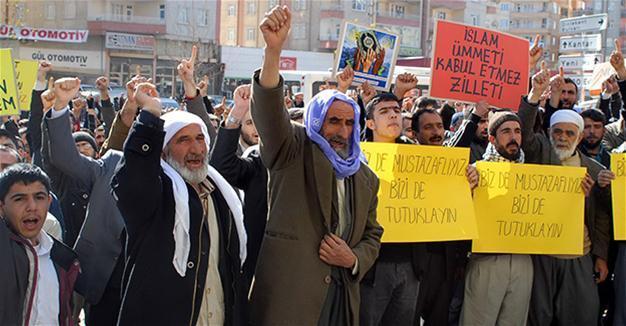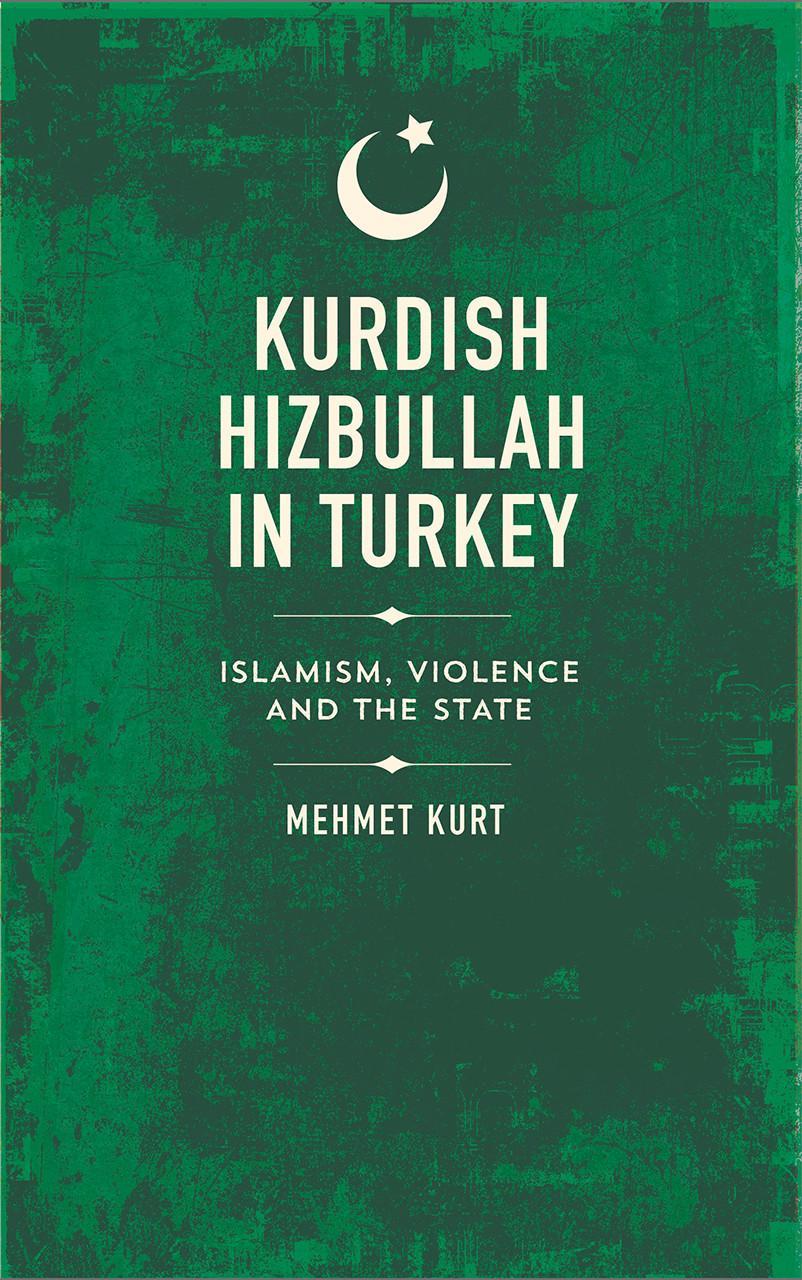Kurdish Hizbullah in Turkey
William Armstrong - william.armstrong@hdn.com.tr

A group of demonstrators protest the detention of alleged members of Hizbullah in Diyarbakır in 2011. DHA photo
‘Kurdish Hizbullah in Turkey: Islamism, Violence and the State’ by Mehmet Kurt (Pluto Press, 208 pages, £54)
Many observers assume that Turkey’s Kurdish question is limited to the war between the state and the outlawed Kurdistan Workers’ Party (PKK). For over three decades that conflict has defined the issue, causing the deaths of over 40,000 people. But there are many other layers to the onion; a broader variety of actors are implicated in Turkey’s Kurdish question
both on the surface and under the radar.

Plenty of ink is spilled about the PKK, but relatively little is written about Hizbullah. The extremist Kurdish Sunni Islamist militant group (not to be confused with the Lebanese Shiite militants of Hezbollah) was particularly active during the 1990s, and its legacy continues in Turkey’s southeast today. “Kurdish Hizbullah in Turkey” by Queen Mary University fellow Mehmet Kurt is a deeply researched and often unsettling new book.
Kurt’s interest is personal, based in his experiences as a student in Mardin in the 1990s at a religious imam-hatip boarding school where Hizbullah was influential and where violence from Hizbullah-inspired students was commonplace. This personal connection gives Kurt extraordinary access to dozens of Hizbullah members past and present – repentant, unapologetic or confused.
Hizbullah was established in the southeastern town of Batman prior to the 1980 military coup. Muslim Brotherhood influence was on the rise in Turkey through the Islamist Milli Görüş (National View) line, while violence between left and right was peaking and the PKK was emerging as a militant force. The 1979 Iranian Revolution poured fuel onto the fire, and Hizbullah members received organizational support and military training from Iran throughout the 1980s. Although Hizbullah was Sunni, the influence of the Shiite regime in Tehran was practical and ideological: Hizbullah’s raison d’etre was to overthrow the secular regime and establish a Sharia-based state, justifying violence through use of religious terminology. It also prioritized action over theory, which motivated many uneducated or poorly educated young people to join.
Hizbullah began recruitment activities in a handful of mosques in the southeast, and by the mid-1990s it was active in almost all the mosques in Diyarbakır. Using similar tactics to the PKK on the left, Hizbullah ruthlessly eliminated or absorbed religious rivals and cohabiting groups like the “Menzils” to secure hegemony over the Islamic right in the southeast. Ultimately a faction headed by Hüseyin Velioğlu emerged on top, and Hizbullah’s grim reputation for violence was secured in the early 1990s when it fought an all-out war with the secular leftist PKK.
Brutal violence had become part of daily life in southeast Turkey and the early 1990s were scarred by extraordinary bloodshed between Hizbullah and the PKK. “Between 1991 and 1995,” Kurt writes, “over 700 people were killed. According to official records, 500 were PKK members or sympathizers while the rest were from Hizbullah. According to my informants, however, the accurate number should rather be in the thousands.”
During this time the Turkish state was also locked in fierce conflict with the PKK. Many claim that the Turkish deep state used Hizbullah as a sub-contractor, or even established it, to fight against the PKK. Although Hizbullah’s ultimate goal was to overthrow the existing regime it never took any action against the state, instead focusing on eliminating rival groups like the PKK. In the early 1990s the security forces and Hizbullah shared an interest in combating the PKK, so it is claimed that the state turned a blind eye to Hizbullah’s raids on PKK members and sympathizers. The authorities carried out a paltry number of operations against Hizbullah during the years when fighting between Hizbullah and the PKK was at its most intense.
Despite his extensive contacts and deep archival research, Kurt writes that it is “not possible to finally confirm the credibility” of many accusations. But he notes that “claims about state-Hizbullah connections are not just voiced by PKK supporters; former Hizbullah members also express similar opinions.” Ultimately, it is probably enough to simply observe that state-Hizbullah collusion likely occurred during the early 1990s as a result of shared interests. “While the Turkish state used Hizbullah in their fight against the PKK, Hizbullah used its tacit impunity for its own agenda,” writes Kurt. In the end, both benefited.
This thesis is reinforced by the fact that security forces only stepped up operations against Hizbullah in the late 1990s, after Hizbullah had almost entirely abandoned violent methods and PKK leader Abdullah Öcalan had been captured. Tens of thousands of Hizbullah members were detained between the mid-1990s and mid-2000s, thousands were jailed, and hundreds were given life sentences. There was also a full-scale crackdown following the killing of Velioğlu by police in January 2000. In that raid in Istanbul’s Beykoz district, police seized weapons and found evidence of industrial scale torture carried out by Hizbullah members,
prompting great public shock.
Hizbullah disintegrated but in 2004 the affiliated Mustazaflar-Der (Association for the Oppressed)
was opened. As the first legitimate group linked to Hizbullah, the association organized demonstrations and conferences in the legal sphere in Turkey’s southeast. Former Hizbullah members abandoned violence as a method, “albeit often implying that violence may again be resorted to if deemed necessary.” Its “Respect for the Prophet” rally in Diyarbakır in 2006 was attended by over 100,000 people, organized in response to the Prophet Muhammed cartoon controversy in Denmark.
The authorities ultimately closed Mustazaflar over links to Hizbullah (still an illegal group). This accelerated plans to launch a political party, and the Hüda-Par (Free Cause) party was launched in 2012. Predictions of the conservative Kurdish Islamist party’s electoral success have yet to materialize, but Hüda-Par’s support for the executive presidential system in the recent referendum may have been crucial in the final result.
Hizbullah’s transformation into a legitimate political party sparked fierce internal dispute, as many sympathizers opposed the move as deviation from hardline Islamic orthodoxy. The emergence of ISIS across the border intensified this debate, as thousands of Turkish Kurds and many former Hizbullah members have joined the jihadists.
The division between conservative religious and secular leftist Kurds also remains potent, often erupting in violence. Dozens on both sides were killed during clashes between PKK sympathizers and Hüda-Par members during the Kobane protests in October 2014, showing how destructively the issue can flare up. As a window into this important but shady subject, “Kurdish Hizbullah in Turkey” is very impressive.
* Follow the Turkey Book Talk podcast via Twitter, iTunes, Stitcher, Podbean, Acast, or Facebook.

 Plenty of ink is spilled about the PKK, but relatively little is written about Hizbullah. The extremist Kurdish Sunni Islamist militant group (not to be confused with the Lebanese Shiite militants of Hezbollah) was particularly active during the 1990s, and its legacy continues in Turkey’s southeast today. “Kurdish Hizbullah in Turkey” by Queen Mary University fellow Mehmet Kurt is a deeply researched and often unsettling new book.
Plenty of ink is spilled about the PKK, but relatively little is written about Hizbullah. The extremist Kurdish Sunni Islamist militant group (not to be confused with the Lebanese Shiite militants of Hezbollah) was particularly active during the 1990s, and its legacy continues in Turkey’s southeast today. “Kurdish Hizbullah in Turkey” by Queen Mary University fellow Mehmet Kurt is a deeply researched and often unsettling new book.